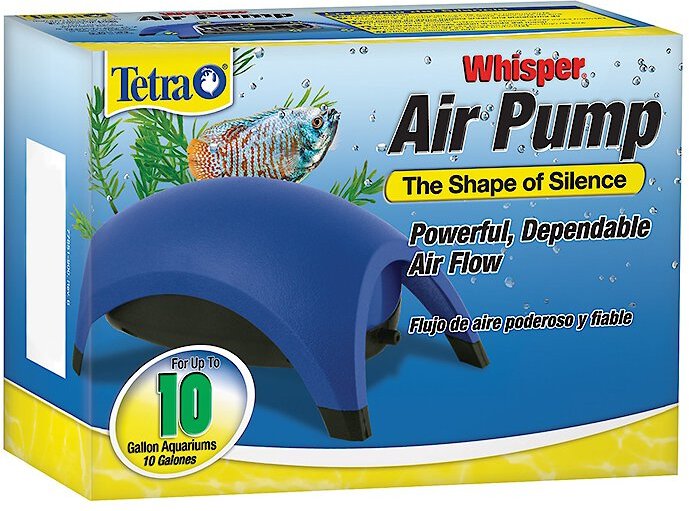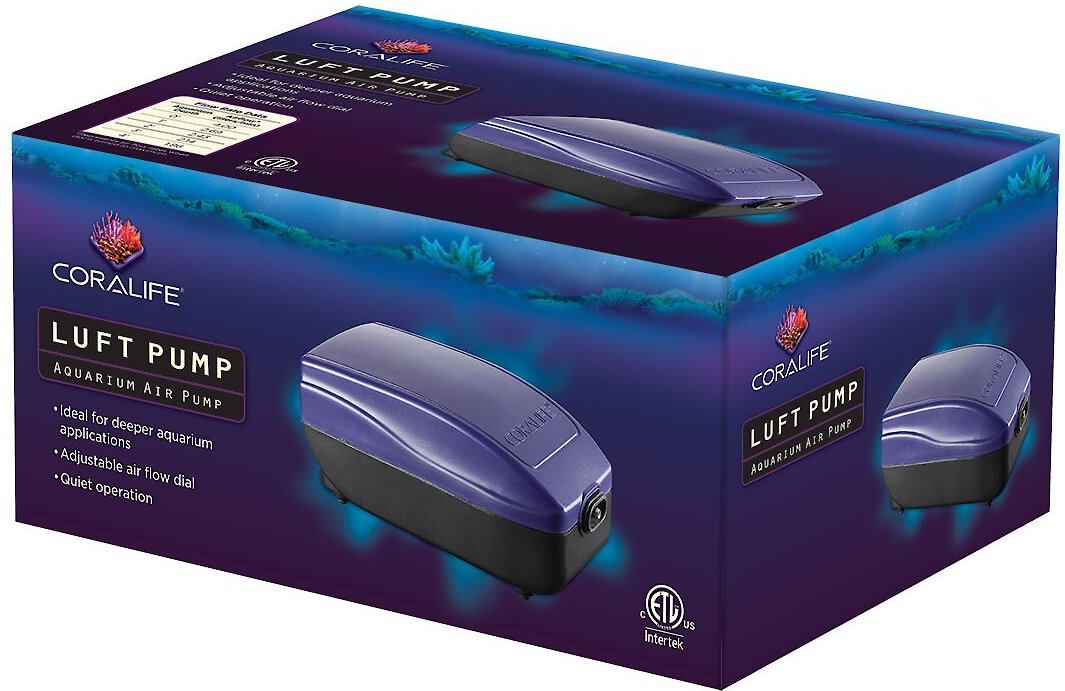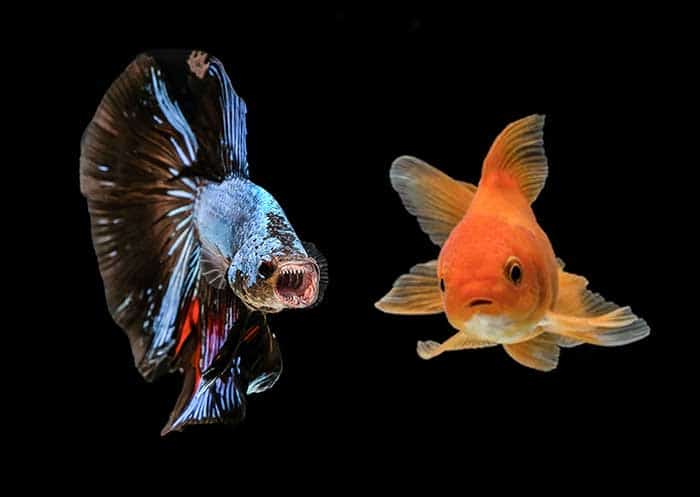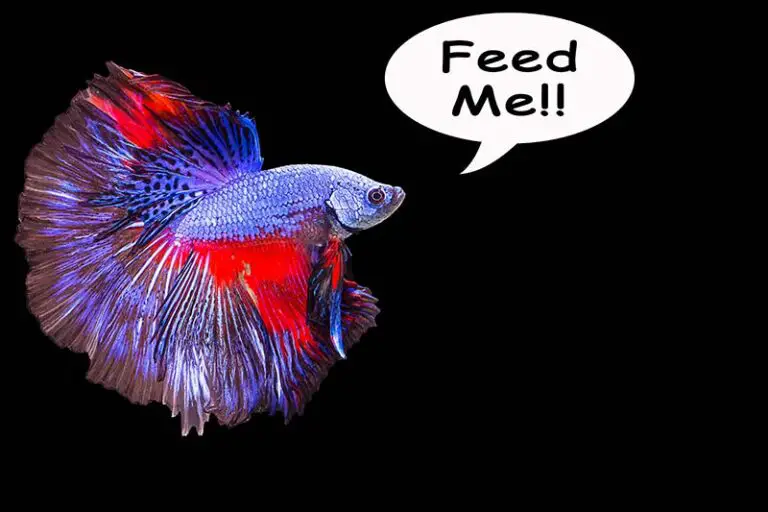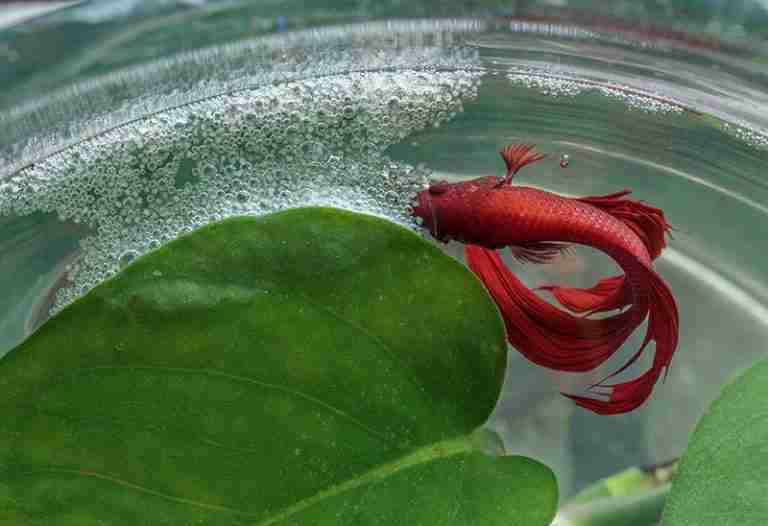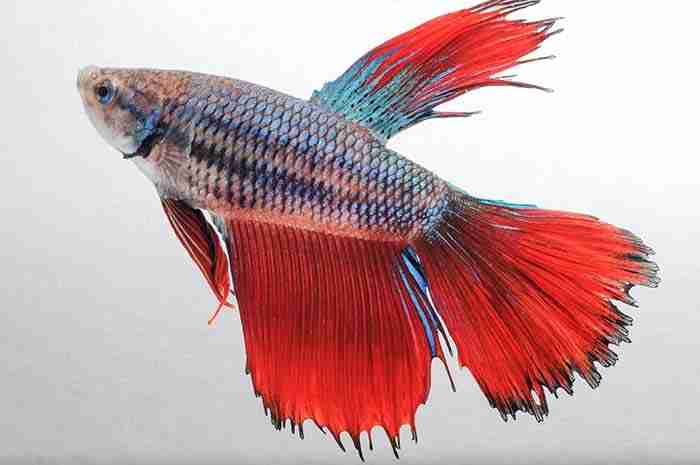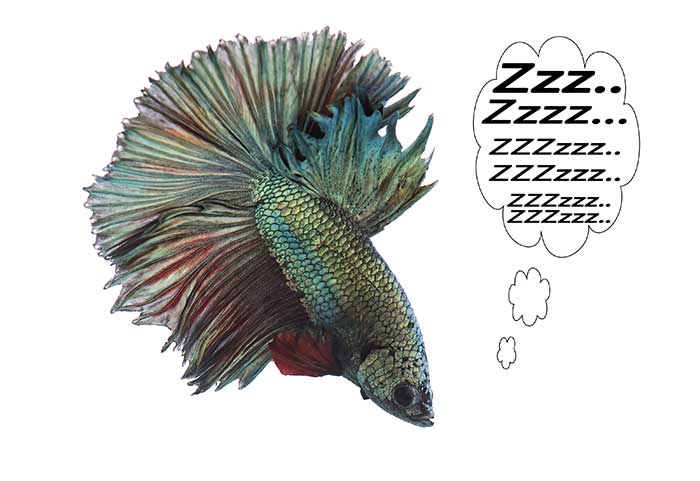Do Betta Fish Need An Air Pump To Oxygenate Their Tank
Air pumps can be visually attractive, they can add much-needed oxygen to a larger tank, and they can help oxygenate a well-stocked aquarium, but do betta fish need an air pump to help them breathe?
Betta fish don’t need an air pump for oxygen as they can use their labyrinth organ to take oxygen from the air. If your betta tank lacks oxygen, there are other methods to aerate the tank, such as adding live plants or creating displacement at the water’s surface with a filter.
Although betta fish don’t need an air pump, there are many circumstances in which they are beneficial, such as:
- Lack of a filtration system.
- Poorly oxygenated water.
- Other fish in the tank would benefit from better oxygenation.
- A tank without any live plants causes a lower level of bio-activity.
The use of air pumps will improve a bettas living conditions in all of the circumstances above and many more.
In this short article, I will talk a little more about a betta’s ability to breathe outside of the water when most fish would suffocate. I also cover the uses of an air pump and the circumstances where a betta fish would benefit from the use of an air pump.

I also have a great article on how to oxygenate a fish tank, which provides lots of information about how and why you need to oxygenate your fish tank.
Do Betta Fish Need Oxygen?
Breathing air is not the same as breathing oxygen. Like all fish, betta fish do need to breathe oxygen. Betta fish are pretty unique because they can breathe oxygen from the water they live in or breathe oxygen from the air outside of their tank.
Oxygen enters the water through a process of gas exchange. As air bubbles pop at the water’s surface, oxygen saturates the water, and carbon dioxide escapes. As oxygen saturates the water, it becomes “Dissolved Oxygen,” which fish breathe when using their gills.
The gas exchange process occurs when there is an agitation of the surface water. The larger the area of surface water (and surface water agitation), the more oxygen can dissolve into the water, increasing overall oxygen levels.
Why Betta Fish Don’t Need Oxygen From Water
Betta fish, also known as Siamese Fighting Fish, are anabantoids (labyrinth fish) because they can breathe in air from their labyrinth organ (located near their mouth). Because of the labyrinth organ, betta fish can survive outside of water, although they don’t usually spend too much time out of the water.
Because betta fish can breathe out of the water, they often jump onto leaves just above the surface to hide from predators, especially when bettas sleep. This isn’t their natural environment and is only a survival instinct.
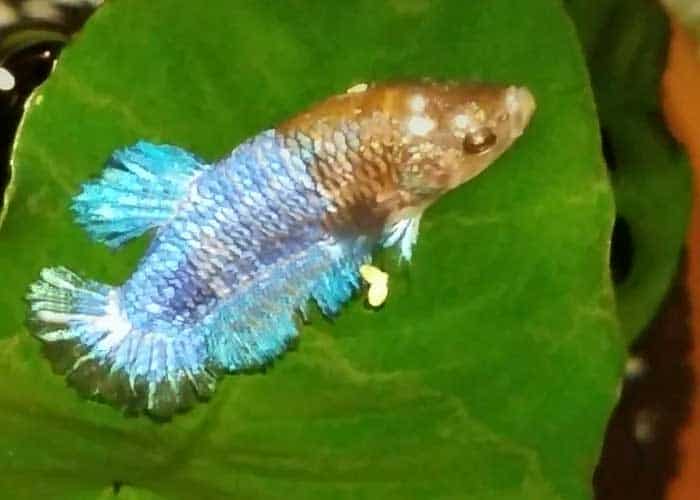
Betta fish are from the family “Macropodusinae” and are in the gourami family “Osphronemidae,” a subfamily of the freshwater “Anabantiform.” Many members of this family are pretty hardy fish and can be found living in oxygen-poor environments that would be too hostile for most other fish.
Note
Labyrinth fish don’t usually have their labyrinth organ from birth and will breathe oxygen from the water using their gills until the organ develops later in life.
Why Do Bettas Gasp For Air?
If a betta fish cannot get the oxygen required from the water, it will move to the surface and breathe air from the atmosphere outside of the tank. This air-breathing can appear like gasping but is entirely comfortable for labyrinth fish.
A sick betta fish may gasp for air which has nothing to do with the level of oxygen in its environment. If your betta is suffering from organ failure or a blood disorder, this may cause them to gasp for air even when there is sufficient oxygen around them, and you should seek further advice from a veterinarian or other fish specialist.
So, Do Betta Fish Need An Air Pump?
Betta fish don’t need an air pump, but if your betta tank is oxygen-deficient, using an air pump can make your betta more comfortable. A betta fish tank with a good oxygen level will help your betta have a healthy gill function, is beneficial to live plants, and promotes the growth of healthy bacteria.
Although they are a straightforward and low-cost solution, air pumps are not the only way to introduce oxygen into your betta tank.
A battery-powered air pump is the cheapest option. It can be easily stored and introduced when power outages occur and will help maintain oxygen levels over these short periods.
Mains-powered air pumps are usually bigger and can typically generate a larger number of bubbles from a more powerful motor, producing an impressive column of air bubbles in your tank.
How Do Aquarium Air Pumps Work?
Air pumps (often called bubblers) produce bubbles in a fish tank. They pull oxygen from outside the tank, sending it through a tube into the aquarium. The tank water doesn’t absorb oxygen directly from these bubbles. Instead, the bubbles rise to the surface and pop, allowing the oxygen to dissolve.
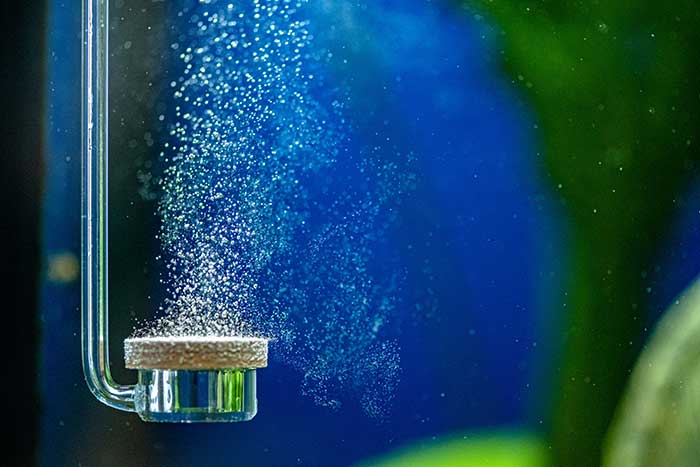
An air pump is usually better suited to taller, narrow betta tanks with a much smaller surface water area, making it more difficult for them to pull enough oxygen naturally from the surface.
Sometimes, larger tanks will benefit from an air pump. An aquarium filter usually provides adequate displacement of the surface water. Still, wider tanks have a much larger surface area, and many filters are not powerful enough to cause the required level of surface agitation.
A larger tank will also struggle to distribute the dissolved oxygen evenly unless there is plenty of water movement.
Adding a more powerful filter to a larger tank also creates a more substantial water current which betta fish don’t like, so that would not be the best solution.
The addition of an air pump will help resolve these issues by increasing surface agitation and providing the oxygen necessary to saturate the water.
If you are considering purchasing an air pump, I have included a couple below that I have used and are well worth looking at.
Tetra Whisper 10 Air Pump
The Tetra Whisper 10 air pump is ideal for small aquariums of up to 10 gallons. A powerful and almost silent pump, perfect for aerating your tank as a stand-alone solution or connecting to an ornament.
Other sizes are available for larger tanks.
Coralife Luft Air Pump
The Coralife luft air pump is perfect for deeper aquariums. Although more expensive than the Tetra Whisper, this air pump offers plenty of power and an adjustable airflow with very little noise or vibration.
One I can definitely recommend if you have a larger tank of over 40 gallons, this air pump has a good build quality and is long-lasting.
How To Use An Aquarium Air Pump
Air pumps can be used in various ways, including:
- Stand-alone – Feed the air pump tube straight into the betta tank to create a bubble effect that will introduce oxygen through gas exchange when bubbles reach the surface.
- Attached to ornaments – Some ornaments will work in tandem with an air pump, and many ornaments will become animated as the air passes through them. Examples of animated ornaments are Clam Shells that open and close as they release bubbles and sand waterfalls that use air to suck sand upwards before letting it fall and giving a waterfall effect.
- With Air Stones – Air stones are porous stones that, when attached to an air pump, will give off a much finer, more consistent column of air bubbles compared to a standard air pump. The finer bubbles are more efficient at dissolving oxygen into the tank water.
Do Bettas Like Air Stones?
Like many fish, bettas do like air stones. You will often see betta fish swimming through the impressive column of air given off by an air stone. Bettas will often flick their body against sand or gravel to remove dead skin or parasites, so this column of air bubbles will give similar relief.
Bettas don’t like strong currents, so a weaker filtration system is preferred, but this will create less water surface movement, reducing the level of oxygenation. An air stone creates bubbles that are so small that they won’t create much of a current by themselves, and this means they are perfect at keeping your betta tank’s water oxygenated.
Male betta fish will also blow bubbles of their own, but these bubbles are not able to oxygenate the tank. Instead, bettas create a bubble nest ready to be fertilized with the eggs of a willing female.
Air Pump Or Filter?
Many people mistake air pumps for filters, especially new fish keepers. Many people talk about their aquarium pumps but do not differentiate between them. Although both an air pump and a filter will help produce oxygen, they are very different in their functions.
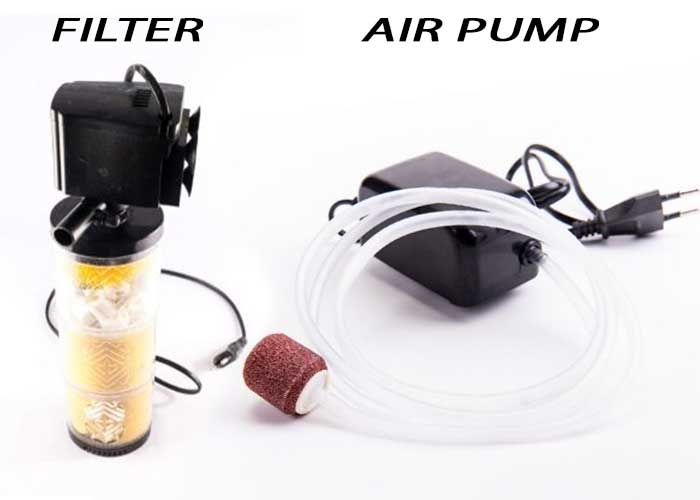
Filters
A filter does just what it says. It filters waste from the water and can stop the buildup of toxins and harmful bacteria. The filter draws in water which gets passed through a sponge or other filtration media before being spat out cleaner. This process creates water movement and surface disturbance, which naturally helps oxygenate the water.
Air Pumps
Air pumps do not filter the water but are better at pulling oxygen into a tank. A motor will pull oxygen from the air outside the tank and pump it into the water via a plastic tube, creating oxygen-rich air bubbles.
In most cases, a filter and some live plants will provide enough oxygen without an air pump, but as explained already, they do have a place and are very useful in many circumstances.
A simple sponge filter is often enough for a betta tank. They sit near the surface, so if too much of a current is created, you can raise it just out of the water, which will cause more surface disturbance and less of a current.
Water Pumps
While on the subject of pumps, I should briefly mention water pumps. They are often connected to a filter of some sort but can be used by themselves. A water pump will help to circulate water around the tank. The circulation of water will have some benefits by adding some oxygen to the water.
Conclusion
So I’ve covered quite a lot in a short article, and trust me, I could have delved much deeper. We have established that betta tanks do not need air pumps, and we have also covered many reasons why they can be beneficial.
It is often believed that as betta fish can breathe oxygen from the air, and they are known to live in oxygen-poor environments, then you don’t need to worry about providing them with adequate oxygen in their tank.
Betta fish may breathe from the air when they cannot get oxygen from the water, but they are still fish, and it will be healthier and more comfortable for them to use their gills in the water. The labyrinth organ will help them when oxygen is low, but this should only be temporary.
An air pump is perfect if your tank setup is not getting the oxygen it requires. You can measure the oxygen saturation level with an oxygen test kit.
Setting up your betta tank correctly, in the beginning, should provide you with a tank that has plenty of oxygen, so the tank would only require the addition of an air pump in emergencies or to power a novelty ornament.
I have a great article: Setting Up A Betta Tank (The right way!), which will provide all the information you will need.


